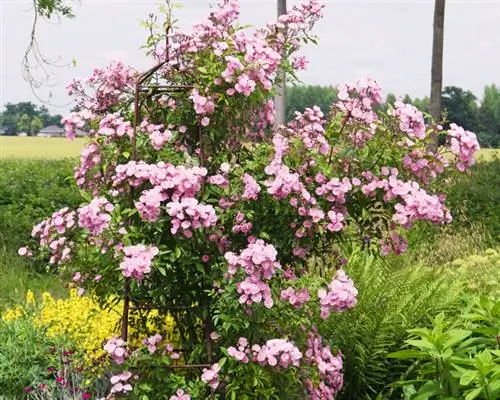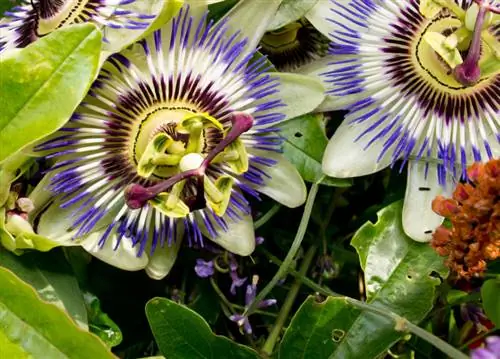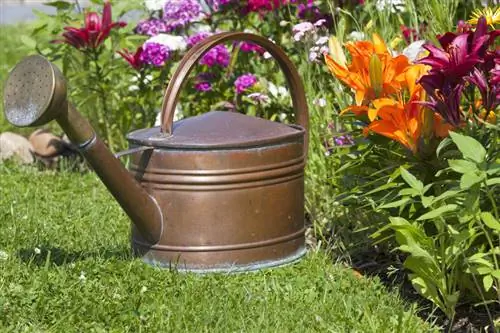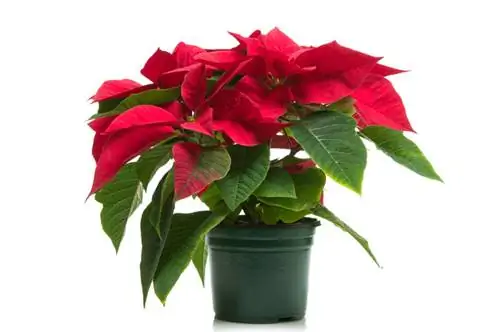- Author admin [email protected].
- Public 2023-12-16 16:46.
- Last modified 2025-01-23 11:20.
Climbing roses are heavy feeders and need a good and sufficient supply of nutrients in order to grow he althily and produce numerous flowers. Freshly planted specimens are only supplied with a little compost, which is mixed with the excavated soil. However, fertilization should be avoided. The supply of climbing roses that are already established in their location depends primarily on the nutrient content of the soil - over-fertilization should be avoided, as this weakens the plants and makes them more susceptible to fungal diseases and pest infestation.
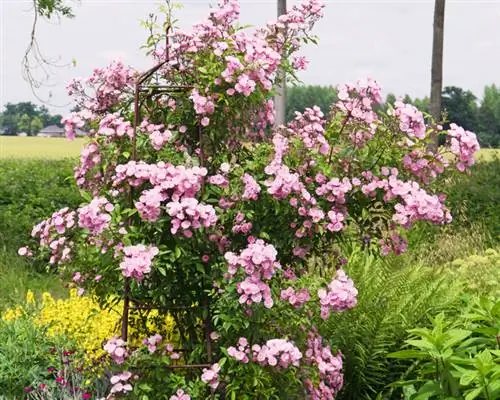
How should you properly fertilize climbing roses?
Fertilize climbing roses three times a year with organic or organo-mineral fertilizer: starting fertilization in early April, refresher fertilization after the first flowering (end of June/beginning of July) and final fertilization in August. Container roses need long-term and liquid fertilizer during the growing season.
The right time for fertilization
Climbing roses should be fertilized three times a year:
- a starter fertilization at the beginning of April
- a refresher fertilization after the first flowering (end of June / beginning of July)
- a final fertilization in August
However, the times mentioned only apply to planted specimens. Instead, container roses should be supplied with a slow-release fertilizer in spring and with a liquid fertilizer during the growing season, as the substrate in the pot is naturally too little or too small.contains no nutrients and the plant therefore relies on external supplies.
Prefer organic fertilizers
Climbing roses should preferably be supplied with organic or organo-mineral fertilizer. In addition to special commercially available rose fertilizer, pure cattle dung is particularly suitable. This has the advantage that it only breaks down slowly and so does not release the nutrients all at once, but continuously in smaller doses over a longer period of time. Purely mineral fertilizers (for example the so-called “blue grain”) are not suitable for fertilizing roses because they contain too much nitrogen. Fertilization that contains a lot of nitrogen weakens the climbing roses and makes them more susceptible to diseases.
Container roses prefer long-term fertilizer
Climbing roses in pots need basic fertilization with a slow-release fertilizer. Addition is usually not necessary for freshly potted specimens because many commercially available rose soils are already pre-fertilized. Only container roses that have been in the same planter for more than a year should be provided with such a long-term fertilizer in spring. During the flowering period, weekly fertilization with an organic liquid fertilizer is also recommended.
Final fertilization with patent potash helps improve winter hardiness
From around the beginning of July - i.e. after the second fertilizer application - climbing roses should no longer be artificially supplied with nutrients (exception: container roses), otherwise the shoots will continue to grow for too long and will not be able to mature in time before the first frost. To support shoot maturity and thus frost resistance, you should fertilize your climbing roses with patent potash between the beginning and middle of August. After this fertilization, the roses should be watered thoroughly so that the potassium reaches the roots.
Tip
If the rose petals are noticeably bright in color, pale and lack the otherwise typical, strong green color, iron deficiency, a so-called chlorosis, is often to blame. A liquid iron fertilizer can help.

